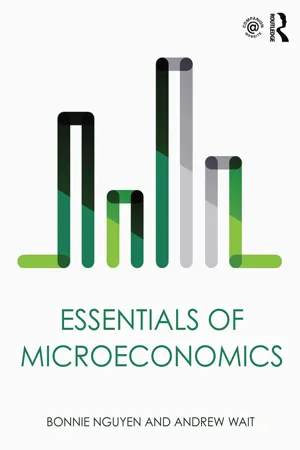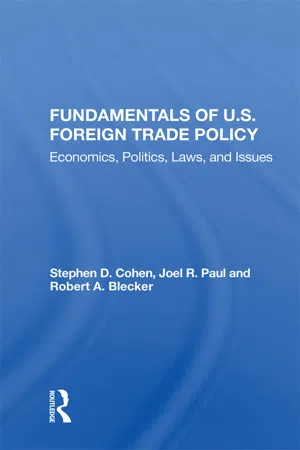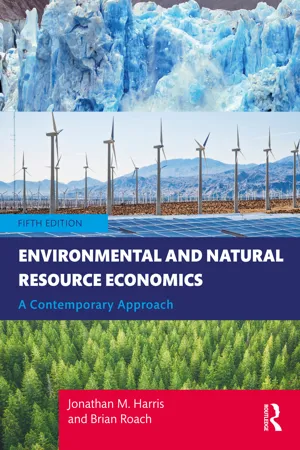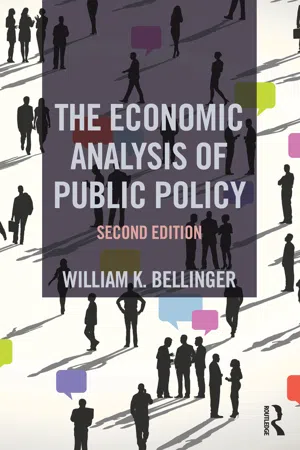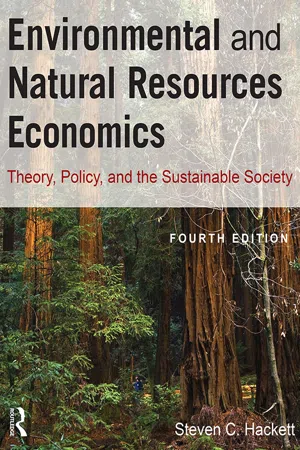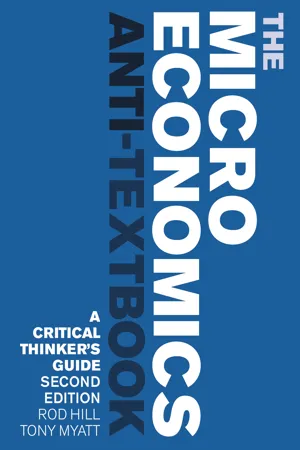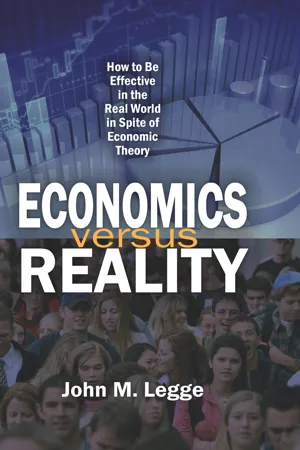Economics
Positive Externalities
Positive externalities refer to the benefits that are enjoyed by third parties as a result of an economic transaction or activity. These benefits are not accounted for in the market price and are often underproduced by the market. Examples include education, healthcare, and environmental conservation. Government intervention, such as subsidies or public provision, is often used to address positive externalities.
Written by Perlego with AI-assistance
Related key terms
Related key terms
1 of 4
Related key terms
1 of 3
11 Key excerpts on "Positive Externalities"
- No longer available |Learn more
- Bonnie Nguyen, Andrew Wait(Authors)
- 2015(Publication Date)
- Routledge(Publisher)
positive externality occurs when the economic activity results in external benefits for a third party. For example, if a student decides to pursue further education, there may be benefits to society as a whole from having better-educated citizens, in addition to the individual benefits that are enjoyed by the student themselves.- A negative externality occurs when the economic activity results in external costs for a third party. For example, if a factory manufacturing wrenches pollutes a river in the course of production, this is a cost borne by people wishing to use the river downstream rather than by the manufacturer or the end consumers of the wrenches.
The following subsections examine the effect of Positive Externalities and negative externalities in turn. To illustrate a positive and a negative externality we first consider a positive consumption externality and a negative production externality.17.2.1 Positive consumption externalities
Consumers derive benefits from consuming goods. However, in the presence of a positive externality, the consumption or production of the good also has external benefits for a third party. Hence, the benefit to society as a whole (the ‘social benefit’) must include both the consumer’s benefit and the external benefit.Formally, the marginal benefit to society of an additional unit of the good is known as the marginal social benefit (MSB). It is made up of two components: the marginal private benefit (MPB) that is enjoyed by the consumer and the marginal external benefit (MEB) that accrues to a third party:17.1M S B = M P B + M E B .Figure 17.1 represents the relationship between the MPB and the MSB. Note that, in the presence of a positive consumption externality, the marginal social benefit is higher than the marginal private benefit – the difference between the MSB and the MPB is the size of the externality, for any given unit. In Figure 17.1 , the increasing gap between the MPB and the MSB indicates that the positive externality is increasing with output. This need not be the case – there could be a constant positive externality per unit of the good consumed, in which case MPB and MSB would be parallel. Alternatively, a diminishing gap between MSB and MPB would represent a declining positive externality as more of the good is consumed. Finally, if there is no positive consumption externality, MEB = 0 and MSB = MPB - eBook - ePub
Health Economics
Demystifying Healthcare Economics, Your Guide to Informed Decisions and a Healthier Future
- Fouad Sabry(Author)
- 2023(Publication Date)
- One Billion Knowledgeable(Publisher)
For instance, manufacturing activities that cause air pollution impose health and clean-up costs on the entire society, whereas the neighbors of individuals who choose to fire-proof their homes may benefit from a decreased risk of a fire spreading to their homes. If there are external costs, such as pollution, the producer may decide to produce more of the product than he or she would if required to pay all associated environmental costs. Due to the fact that responsibility or consequence for self-directed action lies in part outside the self, externalization is present. If there are external benefits, such as public safety, the producer may produce less of the good than if they were compensated for the external benefits to others.Two British economists are credited with initiating the formal study of externalities, or "spillover effects": Henry Sidgwick (1838–1900) is credited with first articulating the concept of externalities, and Arthur C. Pigou (1877–1955) is credited with formalizing it.Because the effect produced on others, whether in the form of profits or costs, is external to the market, we use the term externality.A negative externality is any difference between the private and social costs of an economic agent's action or decision. A negative externality is, in simple terms, anything that imposes an indirect cost on individuals. Toxic gases released by industries or mines are an example of indirect costs; these gases cause harm to individuals in the surrounding area, who must bear the cost (indirect cost) of removing that harm. In contrast, a positive externality is any difference between the private and social benefits of an economic agent's action or decision. A positive externality is defined as anything that provides an indirect benefit to individuals and for which the producer is not compensated. For instance, planting trees improves the appearance of a person's property and cleans the surrounding area.In microeconomic theory, externalities are factored into competitive equilibrium analysis as the social effect, whereas the private market only factors direct economic effects. The social impact of economic activity is equal to the sum of indirect (externalities) and direct factors. Therefore, the Pareto optimal point is where the social marginal benefit equals the social marginal cost. - eBook - ePub
Fundamentals Of U.s. Foreign Trade Policy
Economics, Politics, Laws, And Issues
- Stephen D. Cohen(Author)
- 2019(Publication Date)
- Routledge(Publisher)
externalities. Externalities are costs or benefits to some actors in the economy that are not accounted for by market prices. In cases where there are externalities of any kind, the free market will usually give the wrong "signals" to market participants about how much of the goods to produce, to consume, and to import or export. Whether governments should attempt to intervene in cases of externalities is a separate question, but in theory the right government policies (discussed subsequently) could improve on free market outcomes in these situations.Externalities can be either negative or positive. For example, if a factory emits pollution that injures the health of people who live in the vicinity, but the factory owners do not pay for the costs imposed on the injured people and the people in turn do not receive any compensation for the health costs of the pollution, this is a case of a negative externality. Positive Externalities are beneficial spillovers from one activity to another where the provider of the benefits does not receive compensation, and the beneficiary does not pay for the benefits obtained. An example might be the fact that knowledge generated in computer production can spill over into other lines of production, yet the benefits of the knowledge spillover may not be fully paid for by firms in other sectors that utilize that knowledge (and the computer firms that generate the knowledge are not paid for the benefits they create for others). Positive Externalities are often asserted to be dynamic, which means they are realized only over a period of many years (e.g., the accumulation of know-how through experience with a production process). Such dynamic gains are often claimed for industries favored for infant industry protection in developing countries.18 - eBook - ePub
Economics in Christian Perspective
Theory, Policy and Life Choices
- Victor V. Claar, Robin J. Klay(Authors)
- 2015(Publication Date)
- IVP Academic(Publisher)
Therefore, by pursuing their own self-interest other consumers have the potential to harm or benefit you along the way. But spillover effects like these are not limited to the activities of consumers; producers of goods and services may create similar spillover effects as well. Normally, we tend to think only of the harmful spillovers caused by firms, like air and water pollution, noise or an ugly factory. But sometimes we freely benefit from the self-interested activities of firms. When we walk past a bakery, we enjoy the marvelous aroma. Sometimes, because the land is cheap, a firm that wants to put up a new building will buy property that is currently covered with ugly, abandoned, old buildings. If the landscape improves when the firm razes the old buildings and erects the new, everyone in the neighborhood benefits.Economists have a very specific name for spillover effects such as these, whether positive or negative, or whether they are caused by the actions of producers or consumers. Economists call these spillovers externalities. The late economist Paul Heyne provides a helpful, intuitive definition: externalities are consequences of actions that the actor need not consider when making a decision.Sometimes externalities are negative (smelly perfume or noise pollution) and sometimes they are positive (nice landscaping or a bakery aroma). In the case of negative externalities the cost of the externality-generating activity to society is greater than the one considered by the firm or consumer causing the negative external effect. That is, while the parties engaged in the market part of the activity (the buyer and the seller) enjoy a net mutual benefit, some of us are simultaneously incurring a cost not borne by either the seller or the buyer.With Positive Externalities the total social benefit is even greater than the net benefit enjoyed by those involved in the market part of the activity. Suppose that you replace an old, shabby jacket with a new jacket that really suits you in fit and color. Of course the seller benefits, valuing your money in the cash drawer more than he or she values the jacket in the inventory. And you benefit, since you will feel good about your appearance and will be protected from the elements. But others may benefit as well, if your appearance in the new jacket makes you generally more enjoyable to be around. - eBook - ePub
Environmental and Natural Resource Economics
A Contemporary Approach
- Jonathan M. Harris, Brian Roach(Authors)
- 2021(Publication Date)
- Routledge(Publisher)
positive externality if it benefits those external to the market. An example of a positive externality is a landowner who buys and plants trees. In addition to benefitting the owner, the trees provide benefits to those who appreciate the scenery and to society as a whole because trees absorb carbon dioxide and provide habitat for wildlife.In a basic economic analysis of markets, demand and supply curves represent the costs and benefits of a transaction. A supply curve tells us the marginal cost of production—in other words, the costs of producing one more unit of a good or service. Meanwhile, a demand curve can also be considered a marginal benefit curve because it tells us the perceived benefits consumers obtain from consuming one additional unit. The intersection point of a demand and supply curve gives the equilibrium price at which supply and demand balance, as shown in Figure 3.1 for a hypothetical market for automobiles. This equilibrium (at a price of PM and a quantity of QM) represents a situation of economic efficiency because it maximizes the total benefits from the market—but only if there are no externalities. (See Appendix 3.1 for an overview of supply, demand, equilibrium, and efficiency in markets.)- positive externality the positive impacts of a market transaction that affect those not involved in the transaction.
- marginal cost the cost of producing or consuming one more unit of a good or service.
- marginal benefit the benefit of producing or consuming one more unit of a good or service.
- equilibrium price the market price where the quantity supplied equals the quantity demanded.
- economic efficiency an allocation of resources that maximizes net social benefits; perfectly competitive markets in the absence of externalities are efficient.
Accounting for Environmental Costs
The market equilibrium in Figure 3.1 - eBook - ePub
- William K. Bellinger(Author)
- 2015(Publication Date)
- Routledge(Publisher)
13 , which cover urban transportation and pollution policy, and those discussions depend on a clear understanding of the following concepts.Externalities can be harmful or helpful. For example, water pollution produced by farmers may negatively affect their neighbors or cities downstream. On the other hand, visitors to Hershey, Pennsylvania, are likely to enjoy the aroma rising from the chocolate factory near the center of town. Another example of a positive externality is the more familiar case of the beekeeper and the apple orchard. A beekeeper’s insects will provide great benefits to an orchard located next door through the pollination of its trees. This will happen whether or not the orchard owner pays for this benefit. Therefore, the pollination process is basically external, as are the benefits of pollination to the orchard owner. Of course, the beekeeper will experience a similar benefit from the apple orchard, a source of nectar for the bees.Introductory texts often start the economic analysis of externalities by drawing a distinction between the private, external, and social costs of production. Let’s assume that a factory on a river produces shoes and also water pollution that harms fishermen downstream. The production of these shoes will produce two types of costs, private production costs for the shoe company and external costs to the fishermen. Since both groups belong to society, society’s total costs include both the private and external costs.More explicitly, the firm’s production will lead to two different cost curves, one representing marginal private costs, and the other curve representing marginal social costs. The difference in height between the two curves will equal the marginal external cost or benefit for that unit of production (see Figure 4.8 - eBook - ePub
Environmental and Natural Resources Economics
Theory, Policy, and the Sustainable Society
- Steven Hackett, Sahan T. M. Dissanayake(Authors)
- 2014(Publication Date)
- Routledge(Publisher)
Chapter 7 .Summary
- Positive Externalities are unpaid-for benefits to society generated as a by-product of production and exchange. When there are important Positive Externalities, market demand based on the private benefits of buyers understates the full social benefits of the good or service generating the external benefit. Consequently, too little of the good or service generating the positive externality is produced in otherwise well-functioning competitive markets. Subsidies represent a form of policy intervention that can enhance market efficiency by internalizing the positive externality. Positive Externalities can also affect the supply curve, such as when there are knowledge spillover externalities.
- While the legal system is designed to protect property, open-access and public trust resources were not traditionally protected under common law from pollution harms and thus remain subject to degradation. The legal system does not function perfectly, of course, and so pollution harms to people, their homes, and other valuable objects that are property do regularly occur. One problem is in determining the source of the pollution when there may be very large numbers of emitters, as is the case with automobile exhaust.
- Negative externalities are uncompensated damage costs borne by members of society. These negative externalities are generated as a by-product of production and exchange. Profit-maximizing firms have an incentive to transform private costs into negative externalities (external costs) in the absence of regulation or reputation effects. When there are important negative externalities, market supply based on private costs to sellers is too large, leading to too much of the good or service generating the negative externalities being produced in otherwise well-functioning competitive markets. Pigouvian taxes represent a form of policy intervention that can enhance market efficiency.
- eBook - ePub
- E.J. Mishan, Euston Quah(Authors)
- 2020(Publication Date)
- Routledge(Publisher)
When such externalities first appeared in the literature, they tended to be regarded, if not quite as curiosa, as in the nature of a refinement of economic analysis, one having limited applications. For among the older textbooks, at least, as among the population at large, there was a tacit presumption in favour of the spread of industry, the prevailing conviction being that, although the establishment of additional plant and equipment might cause some local inconvenience, the growth of industry would, on balance, confer economic benefits to society as a whole.With the passage of time, it was realized that externalities had wide application, not simply as between firms in connection with the optimal size of an industry – which may be referred to as external effects internal to the industry – but also as between industries themselves or, more generally, as between different economic activities in which the gains of one or more groups are at the expense of others.2 Familiar examples of negative spillovers include the manifold adverse ecological repercussions on flora and fauna, and on the climate and soil, in clearing the trees of forest land.1Other examples within urban areas include the traffic congestion suffered by all drivers along roads and highways, the noise or pollution suffered by people in the vicinity from the operation of industry or of its products, and the consequent effects on people’s health and longevity. Even the offence to citizens given by the erection of some tasteless or incongruous building or other structure may properly be regarded as a spillover – as, indeed, would the reverse of this, the pleasure in a beautiful building enjoyed by citizens being properly regarded as a positive spillover.From a little reflection on examples such as these, it emerges that one characteristic common to all of them is the incidental or unintentional nature of the effect produced. The person or industry engaged, say, in logging may or may not have any idea of the consequences on the profits or welfare of others. But it is certain that they do not enter into his calculations. The factory owners, whose plant produces smoke as well as other things, are concerned only to produce the other things that can be sold on the market. They have no interest in producing the smoke, even though they may be fully aware of it. But so long as their own productivity does not suffer thereby, and they themselves are not penalized in any way, they will regard the smoke as an unfortunate by-product. - eBook - ePub
The Microeconomics Anti-Textbook
A Critical Thinker's Guide - second edition
- Rod Hill, Tony Myatt(Authors)
- 2021(Publication Date)
- Zed Books(Publisher)
The most obvious examples where both consumers and producers have been failing to pay the full social costs are the activities that contribute to climate change. The standard texts typically mention this issue in their chapter on externalities. Because of its critical importance, a Postscript chapter is devoted to this, examining the content of the texts and providing an anti-text critique. Unfortunately, as we will see, there is no shortage of other pervasive and serious externalities to consider.Included in this chapter are two other kinds of goods. External costs play a central role in the analysis of ‘common access resources’ such as water or wild fish, where people using the resource impose costs on others. The concepts of external benefits and costs also appear when considering ‘public goods’ (or ‘public bads’) to which everyone has free access and where no one’s use of the good (or bad) reduces others’ ability to consume it – for example, a quiet (or an unpleasantly noisy) street.1 The Standard Text1.1 ExternalitiesSuppose that you’re making a decision about how much to drive your car in a week. You weigh the benefits to you of doing various things (going to work, shopping and so on) against the costs you have to pay: fuel, and wear and tear on your car, for example.The result of this rational choice is illustrated in Figure 7.1 - eBook - ePub
Economics versus Reality
How to be Effective in the Real World in Spite of Economic Theory
- John Legge(Author)
- 2017(Publication Date)
- Routledge(Publisher)
It can be convincingly argued that the creation of a pool of landless laborers and replacing strip agriculture by relatively large farms greatly increased productivity and the general wealth of England during the late sixteenth through the eighteenth centuries. The enclosures of the eighteenth century created the migratory labor force that worked in the mines, shipyards, and factories of the Industrial Revolution. The general increase in prosperity and living standards came at a heavy cost in disruption, destitution, and death among the English yeomanry while the greater part of the benefits was concentrated in very few hands.Externalities are not all bad: Romer’s theory of endogenous growth4 relies on the assumption of Positive Externalities to innovation. Many innovations have generated large Positive Externalities: Walter Oi pointed out that Willis Haviland Carrier’s invention of air conditioning generated vast economic benefits;5 and while the Carrier Company prospered, it captured a small fraction of the total value created.Tropical and subtropical cities like Singapore and Houston could not have attained their present eminence without air conditioning; the US Congress could not legislate in the summer months before air conditioning; and the British textile industry would not have evaporated in the second half of the twentieth century without air conditioning in the developing-country factories that replaced it.Economic debates over national industry policies and national innovation policies generally boil down to an argument about whether the value created by such Positive Externalities outweighs the generalized economic costs implicit in establishing and maintaining such policies. Neoliberals tend to fall back on anecdotal evidence, and there are plenty of well-verified accounts of governments supporting fatally flawed ventures to add color to their arguments. On the other hand, there are well-verified accounts of industries that were brought into existence with extensive government assistance.The Boeing 747 “jumbo” revolutionized air travel. The initial design was completed and prototypes flown under a development contract paid for by the US Department of Defense. The Internet began life as the Arpanet, also a US Department of Defense project, as did the Global Positioning System (GPS), without which many popular apps could not work. Neoliberals, when confronted with the East Asian miracles of Japan, South Korea, and Taiwan, fall back on an unverifiable and implausible claim that the population of these countries would be even better off today had the post–World War II governments pursued laissez-faire policies. - eBook - ePub
- Paul Downward, Bernd Frick, Brad R. Humphreys, Tim Pawlowski, Jane E. Ruseski, Brian P. Soebbing, Paul Downward, Bernd Frick, Brad R. Humphreys, Tim Pawlowski, Jane E. Ruseski, Brian P. Soebbing(Authors)
- 2019(Publication Date)
- SAGE Publications Ltd(Publisher)
experienced utility. The latter nests externality effects within it. Experienced utility may be, for example, captured in relational goods (Rasciute, Downward, & Greene, 2017) and is connected with the formation of social capital. More generally, it is recognising these theoretical issues that has led, following Stiglitz et al. (2010), to an attempt to measure social welfare directly by asking about an individual's utility expressed as subjective well-being (SWB) (Frey, 2008). As a result, in the United Kingdom (UK), SWB is now considered to be an important concept to measure in evaluating alternative policy outcomes and investment (HM Treasury, 2011). These developments bring with them recognition that SWB is multifaceted and can comprise physical and mental health, and in part affect, and also to be influenced by the personal, social and economic development of individuals that might stem from policies, such as those connected with the promotion of sport events.Review of Evidence
This section reviews existing research exploring the externalities of sport events. The above discussion indicates that the policy narrative tends to focus on positive outcomes. The discussion below also includes some consideration of negative externalities, which tends to draw upon the sports league context, though it is clear that parallels for future research might be made. The assignment of externalities to positive or negative is made based on their claimed effect in policy document; hence health is listed among Positive Externalities. The discussion includes both hosting and attending sport events as well as sporting success. Indicative references are provided throughout.Positive Externalities
Health and Subjective Well-being
Following the World Health Organisation (WHO, 2010), a person's individual health status consists of two components, physical health and mental health. Physical health is typically assessed with the absence of various diseases, such as obesity, cancer, hypertension, osteoporosis, cardiovascular heart diseases, or type 2 diabetes (e.g., Humphreys, McLeod, & Ruseski, 2014; WHO, 2010) or with an individual's subjective perception of his/her health status (e.g., Downward et al., 2016). Mental (or psychological) health is regarded as the absence of mental disorders, like anxieties and depression, or cognitive decline (WHO, 2010), and is captured in epidemiological studies using respective measures (e.g., Fergusson et al., 2015). Sports economists have mainly studied SWB – ‘a person's cognitive and affective evaluations of his or her life’ (Diener, Oishi, & Lucas, 2002, p. 53) – using self-reported measures for individual life satisfaction (e.g., Kavetsos & Szymanski, 2010) or happiness (e.g., Pawlowski et al., 2014). These measures can also be regarded as early indicators of potential mental health issues (Koivumaa-Honkanen, Kaprio, Honkanen, Viinamaki, & Koskenvuo, 2004). Considering the perspective of sports economics and the terminology within the field, this chapter refers to physical health as health and uses the terms SWB, happiness, and life satisfaction interchangeably, reflecting the psychological dimension of health.
Index pages curate the most relevant extracts from our library of academic textbooks. They’ve been created using an in-house natural language model (NLM), each adding context and meaning to key research topics.
Explore more topic indexes
Explore more topic indexes
1 of 6
Explore more topic indexes
1 of 4
